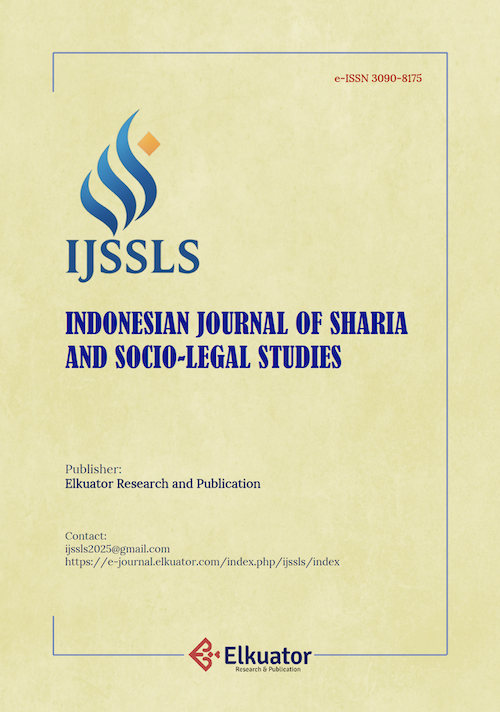Antar Pakatan and the Reproduction of Social Solidarity: A Cultural Strategy for Addressing the Economic Burden of Customary Marriage in the Sambas Malay Community
DOI:
https://doi.org/10.24260/ijssls.1.1.12Keywords:
Antar Pakatan, Customary Marriage, Economic Redistribution, Malay Community, Social SolidarityAbstract
In communal societies, the celebration of traditional weddings often places a significant financial burden on host families, particularly in communities that uphold strong cultural values and social honor. This challenge is also faced by many lower- to middle-income families in Sambas Regency, West Kalimantan. This article analyzes the antar pakatan tradition practiced by the Sambas Malay community as a culturally embedded social strategy to mitigate the high costs associated with customary wedding ceremonies. Utilizing a qualitative field research methodology with a socio-legal approach, the study draws on in-depth interviews and non-participant observations conducted in Sepadu Village, Sambas Regency. The findings reveal that antar pakatan functions as an informal mechanism of economic redistribution, grounded in the values of mutual assistance and collective participation, which are realized through voluntary contributions from guests. This tradition effectively alleviates financial pressure without diminishing the symbolic significance of customary rituals, while reinforcing social solidarity through culturally institutionalized reciprocal relationships. This article argues that antar pakatan represents a customary institution capable of bridging the sustainability of tradition with the need to adapt to contemporary economic challenges. Furthermore, it contributes theoretically to the study of social exchange dynamics within value-based communal societies.
[Dalam konteks masyarakat komunal, pelaksanaan pesta pernikahan adat sering kali menjadi beban ekonomi yang signifikan bagi keluarga penyelenggara, terutama dalam komunitas yang menjunjung tinggi nilai-nilai kultural dan kehormatan sosial. Hal serupa juga dialami oleh sebagian keluarga yang berpenghasilan menengah ke bawah di Kabupaten Sambas. Artikel ini bertujuan untuk menganalisis tradisi antar pakatan yang dipraktikkan oleh komunitas Melayu sebagai solusi sosial berbasis kearifan lokal dalam menghadapi tingginya biaya penyelenggaraan pernikahan adat. Penelitian ini menggunakan metode kualitatif lapangan dengan pendekatan sosio-legal, melalui wawancara mendalam dan observasi non-partisipan yang dilaksanakan di Desa Sepadu, Kabupaten Sambas. Hasil penelitian menunjukkan bahwa tradisi antar pakatan berfungsi sebagai mekanisme informal redistribusi ekonomi yang dilandasi nilai gotong-royong dan partisipasi kolektif, yang diwujudkan melalui kontribusi sukarela dari tamu undangan. Tradisi ini secara efektif mereduksi tekanan finansial tanpa menghilangkan makna simbolik dalam penyelenggaraan adat, sekaligus memperkuat solidaritas sosial melalui relasi timbal balik yang dilembagakan secara kultural. Artikel ini berargumen bahwa tradisi antar pakatan merepresentasikan pranata adat yang mampu menjembatani antara keberlanjutan tradisi dan adaptasi terhadap tantangan ekonomi kontemporer, serta memberikan kontribusi teoretis terhadap kajian mengenai dinamika pertukaran sosial dalam masyarakat berbasis nilai.]
References
Akanle, Olayinka, Adefolake Olusola Ademuson, and Olufunke Olufunsho & Oguntoyinbo Adegoke. “This Is Who We Are and Why!: Ethnography of Weddings in Ibadan, Nigeria.” African Population Studies 33, no. 1 (2019): 4686–99.
Albattat, Ahmad, Trisha Anne Joseph, and Abdul Azim Mazlan. “The Impact of Modernization on Malay Weddings.” In Event Tourism in Asian Countries, 10. Apple Academic Press, 2022.
Azhari, Fathurrahman, Hariyanto, and Muhammad Rifqi Hidayat. “Giving Jujuran in Socio-Cultural Marriage of Banjar Community.” Kasetsart Journal of Social Sciences -- Formerly Kasetsart Journal (Social Sciences) 045, no. 1 (2024): 215–24. https://doi.org/10.34044/j.kjss.2024.45.1.22.
Barsukova, Svetlana. “Bank Loans vs Debt within Social Networks: The Case of Central Asia.” Terra Economicus 20, no. 3 (September 25, 2022): 87–97. https://doi.org/10.18522/2073-6606-2022-20-3-87-97.
Barsukova, Svetlana Yu. “Financial Rationality vs Traditions: On Wedding Costs of Medium Income Urban Families in Kazakhstan.” Sotsiologicheskie Issledovaniya, no. 5 (May 15, 2024): 128–40. https://doi.org/10.31857/S0132162524050109.
DI. Interview with a Malay Traditional Leader in Seladu Village, November 2024.
Field Notes from Observation of the Antar Pekatan Tradition, October 2024.
Homans, George Caspar. Social Behavior; Its Elementary Forms. New York: Harcourt, Brace, Jovanovich, 1974.
Ibrahim, Ibrahim. “Al-Ṭuqūs wa ‘Alāqatuhā bi Huwīyat Muslimī Ulu Kapuas, Kalimantan al-Gharbīyah.” Studia Islamika 25, no. 3 (December 4, 2018): 543–88. https://doi.org/10.15408/sdi.v25i3.6579.
Jiménez-Marín, Gloria, Pedro Correia, and Irene García Medina. “Análisis Del Impacto Turístico De La Organización De Bodas En La Zona Del Caribe.” Revista Turismo & Desenvolvimento, October 21, 2021, 89–109. https://doi.org/10.34624/RTD.V37I0.26335.
Kar, Rabi Narayan, and Kusha Tiwari. “Is the New Normal Driving Sustainability: Evidence from Indian Wedding Industry.” International Journal of Innovation and Sustainable Development 18, no. 1/2 (2024): 91–105. https://doi.org/10.1504/IJISD.2024.135258.
Khairuddin, Doli Witro, Wiji Nurasih, Hetri Yulianti, and Anisah Agustina. “Belo Bellen as Compulsory Delivery in Aceh Singkil Wedding; ‘Urf and Islamic Law Anthropology Review.” AL-IHKAM: Jurnal Hukum & Pranata Sosial 19, no. 1 (June 15, 2024): 151–73. https://doi.org/10.19105/al-lhkam.v19i1.10222.
Khalid Ali, Khalidah. “A Discourse on the Malay Cultural Identity Within the Malaysian Society.” Kajian Malaysia 40, no. 1 (April 27, 2022): 83–107. https://doi.org/10.21315/km2022.40.1.5.
Khoo, Siew-Ean. “Educational Attainments, Inter-Ethnic Marriage and Social Cohesion.” In Social Cohesion in Australia, edited by Emma Dawson, James Jupp, and John Nieuwenhuysen, 114–28. Cambridge: Cambridge University Press, 2007. https://doi.org/10.1017/CBO9780511481574.012.
Kristianus. “Nasionalisme Etnik di Kalimantan Barat.” Masyarakat Indonesia 37, no. 2 (December 19, 2011): 147–76. https://doi.org/10.14203/jmi.v37i2.637.
Mardiyanti, Lisa Ranti, Iwan Ramadhan, and Heri Kurnia. “Profil Melayu Sambas dalam Konteks Asal-Usul, Tradisi dan Budaya di Kalimantan Barat.” Jurnal Ilmu Sosial dan Budaya Indonesia 1, no. 1 (May 1, 2023): 1–9. https://doi.org/10.61476/js62h161.
Miri Ghaffarzadeh, S., H. Nazari, and N. Saadat. “Wedding Celebration Customs of West Azerbaijan and Urmia in Tradition.” Life Science Journal 9, no. 4 (2012): 4811–14.
Mohad Sallehuddin, Mohd Khairuddin. “New Mediators in Consumerism Activity on Malay Wedding.” Pertanika Journal of Social Sciences and Humanities 31, no. 1 (February 17, 2023): 125–38. https://doi.org/10.47836/pjssh.31.1.07.
Moore, Erin V., and Nanna Schneidermann. “Women Who Pay Their Own Brideprice: Reimagining Provider Masculinity Through Uganda’s Thriving Wedding Industry.” Journal of the Royal Anthropological Institute 31, no. 2 (June 2025): 493–512. https://doi.org/10.1111/1467-9655.14229.
MS. Interview with a Malay Traditional Leader in Seladu Village, December 2024.
Mustansyir, Rizal. Kearifan Lokal Masyarakat Melayu Sambas dalam Tinjauan Filosofis. Yogyakarta: Fakultas Filsafat UGM, 2015.
Muthalib, Kismullah Abdul, Dohra Fitrisia, and Nia Zahara. “Ceremonial Language and Social Cohesion: An Analysis of Seumapa in Acehnese Wedding Traditions.” Studies in English Language and Education 11, no. 2 (June 13, 2024): 1231–47. https://doi.org/10.24815/siele.v11i2.29512.
Nurmawati, Nurmawati, Zulfitri Zulfitri, Mauloeddin Afna, and Khairul Amri. “The Projection of Cultural Shift Rejuvination about Fostering Islamic Education and its Counterpart within Malay Community.” Jurnal Ilmiah Peuradeun 8, no. 1 (January 30, 2020): 1–16. https://doi.org/10.26811/peuradeun.v8i1.387.
Pauli, Julia. “Celebrating Distinctions: Common and Conspicuous Weddings in Rural Namibia.” Ethnology 50, no. 2 (2011): 153–67.
Pemerintah Daerah Sambas. “Laporan Kinerja Instansi Pemerintah Kabupaten Sambas.” Sambas: Pemerintah Daerah Sambas, 2022.
Polit, Karin. “Gifts of Love and Friendship: On Changing Marriage Traditions, the Meaning of Gifts, and the Value of Women in the Garhwal Himalayas.” International Journal of Hindu Studies 22, no. 2 (August 2018): 285–307. https://doi.org/10.1007/s11407-018-9234-4.
Provis, René. “Shifting Social Dynamics and Economic Inequality in the Post‐Soviet Space: Networking and Participation in Toi among the Novyi Kyrgyz.” Economic Anthropology 2, no. 2 (June 2015): 371–84. https://doi.org/10.1002/sea2.12037.
Purnama, Handika. “Hukum Islam, Adat dan Hukum Negara dalam Perkawinan Masyarakat Suku Melayu di Pekanbaru Riau: Keabsahan, Etika, dan Administrasi Perkawinan.” Al-Ahwal: Jurnal Hukum Keluarga Islam 14, no. 1 (May 4, 2021): 1–10. https://doi.org/10.14421/ahwal.2021.14101.
Putra, Purniadi, Galuh Nashrulloh Kartika MR, Abdul Hafiz, Dendi Pratama, and Abdul Samad. “The Use Malays-Sambas Expressions in Developing Character Education in Sambas Primary Madrasah in Millennial Era.” Jurnal Ilmiah Peuradeun 9, no. 2 (May 30, 2021): 329–44. https://doi.org/10.26811/peuradeun.v9i2.482.
Puyu, Darsul S., Subehan Khalik Umar, Hasdin Hanis, Bustanul Arifin, and Muhammad Abili. “Mansai in the Marriage Tradition of the Banggai Ethnic in Central Sulawesi, Indonesia: A Living Sunnah Perspective.” Samarah: Jurnal Hukum Keluarga dan Hukum Islam 7, no. 3 (July 12, 2023): 1352–72. https://doi.org/10.22373/sjhk.v7i3.16510.
SA. Interview with a Malay Traditional Leader in Seladu Village, November 2024.
Saiin, Asrizal, M. Hasbi Umar, Badarussyamsi Badarussyamsi, Moh. Zaidi Hajazi, and Maulana Yusuf. “The Domination of Islamic Law in Customary Matrimonial Ceremonies: Islamic Values within the Malay Marriage Tradition in Kepulauan Riau.” Al-Ahwal: Jurnal Hukum Keluarga Islam 16, no. 2 (December 29, 2023): 320–41. https://doi.org/10.14421/ahwal.2023.16207.
Suryahartati, Dwi, Firya Oktaviarni, Windarto Windarto, Sukamto Satoto, and Suhermi Suhermi. “The Local Customary Law: The Contribution of Adat Law in Preserving the Lubuk Larangan in Jambi.” Jambe Law Journal 4, no. 1 (November 14, 2021): 43–68. https://doi.org/10.22437/jlj.4.1.43-68.
Suzuki, Mizuhiro. “Affording Expensive Ceremonies: Evidence from Quinceañeras in Mexico.” Journal of Development Economics 174 (May 2025): 103448. https://doi.org/10.1016/j.jdeveco.2024.103448.
Tade, Oludayo, and Magdaline Aimeanota Nnamani. “Symbolic Status of Space: Event Centre Culture and Patronage in Nigeria.” Journal of Asian and African Studies 52, no. 5 (August 2017): 646–56. https://doi.org/10.1177/0021909615605530.
Trevisani, Tommaso. “Modern Weddings in Uzbekistan: Ritual Change from ‘Above’ and from ‘Below.’” Central Asian Survey 35, no. 1 (January 2, 2016): 61–75. https://doi.org/10.1080/02634937.2015.1114781.
Downloads
Published
Issue
Section
License
Copyright (c) 2025 Muhammad Syarif, Khamim

This work is licensed under a Creative Commons Attribution-NonCommercial 4.0 International License.















